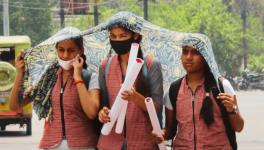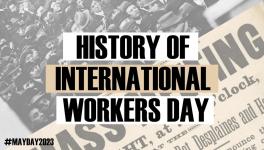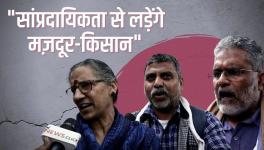Reel Coolie Survived, Real Working-Class Hero Died
Representational use only.Image Courtesy: Wikimedia Commons
Some 40 years ago, Amitabh Bachchan nearly died while shooting for Manmohan Desai’s potboiler Coolie—for a few minutes, he was “clinically dead”. During a prolonged surgery at Mumbai’s Breach Candy Hospital Trust, doctors pumped him with 40 ampoules of cortisone and 60 bottles of blood.
Bachchan’s miraculous recovery made Manmohan Desai change his script. In the original version, the hero was to die in the climax. This might not have been a problem at any other time, but the near-fatal accident made Desai decide that his character had to live in the end.
Desai’s original script probably had a more apt ending for Coolie’s eponymous hero. Bachchan played a railway porter who led a team of other coolies to take on a rich businessman. It was a story of workers triumphing over capitalists.
The movie’s popular scenes included workers barging into a rich man’s mansion and bathing and washing clothes in his swimming pool. It is a symbolic storming of the citadel of the rich.
An even more iconic scene was the fight sequence where Bachchan magically comes across a sickle and a hammer. He holds them against his face, like the universal sign used by communist parties worldwide—his red coolie uniform only adds to the symbolism. If anyone doubts Desai’s deliberate message, they only have to look at Coolie’s publicity posters. Bachchan’s hammer-and-sickle pose is its dominant image.
How did such overtly socialist, nay communist, symbolism enter a mainstream Hindi commercial movie? The answer lies in the year it was released—1983.
Coolie was planned, shot and released in the middle of India’s most famous and longest workers’ strike. The Great Bombay Textile Mill strike began in early 1982 and lasted nearly two years. Over two-and-a-half lakh workers struck work under the leadership of Datta Samant. The strike directly affected 7-8 lakh people and became the single-biggest socio-political event in Mumbai in those couple of years.
By the time Coolie was released, the prolonged strike had failed to get the workers any benefits. The government, babus and the official workers union RMMS colluded to favour the mill owners. More than 90,000 mill workers were laid off, and those who returned got lower pay and faced humiliation and violence on the shop floor. A majority had to sign bonds admitting that their agitation was illegal and that they will never strike work again.
It was a demoralising defeat that not only affected workers in Mumbai but had a chilling effect on worker unions who had held great hopes of the textile workers emerging as victors across the country.
Coolie was not the only film of that year to celebrate working-class unity. Mazdoor, made by the successful director-producer BR Chopra, had a similar theme around working-class heroes coming together to run their own company. One of the movie’s songs—“Hum mehnatkash is duniya se jab apna hissa maangenge, ik baagh nahin, ik khet nahin, hum saari duniya maangenge (When we, who toil, ask for our share from the world, we will not just ask for a garden or a farm, we will ask for the entire world)”—became very popular and got repeat runs Doordarshan.
Two top commercial cinema directors had sensed that making working-class themed movies would sell in India then. Subsequently, the working-class hero would vanish, mirroring the disappearance of working-class concerns from popular discourse.
In one sense, Coolie and Mazdoor represent a crucial turning point in India’s political-economic history. The early 1980s marked the beginning of a gradual process by which the State dismantled ‘Nehruvian socialism’. It started with Indira Gandhi’s return to power in 1980, followed by negotiations for an IMF loan and her subsequent USA visit.
Although the government managed to ward off more radical pro-market reforms proposals that the USA was pushing for, it agreed to “consult with the Fund on the adoption of any appropriate measures consistent with the national policies accepted by Parliament in accordance with policies of the Fund on such consultation.”
By the time the Mumbai textile workers went on strike, the political class and the bureaucracy were already preparing for market-oriented reforms that would undermine workers’ rights to promote unbridled capitalist development. It would be a sharp U-turn in India’s economic policy structure and the middle class and the intelligentsia were perched right at the end of that hairpin bend.
As the State hardened its stand against workers, so did the media. From the mid-1980s, especially after Rajiv Gandhi became PM, the media actively promoted anti-socialist, pro-market and pro-privatisation rhetoric. It would jettison its position as the upholder of a poor country’s social conscience and wholeheartedly embrace middle-class consumerism.
National newspapers began to cover consumer trends and fashions as regular features—sometimes bringing them right onto the front page. What began slowly in the second half of the 1980s, would become the basic standard by the early 1990s.
One story I heard during my short stint in a national newspaper typifies this change. This supposedly happened in the early 1990s, when Cable TV first entered our living rooms.
A senior executive in a national newspaper had called a meeting of editors where he posed a question: “Imagine,” he said, “two things have happened on the same day—a fire broke out in Dharavi killing 70 people and a power cut in South Bombay caused people to miss the latest episode of the Bold and the Beautiful (a popular American show of that time). Which one would be the top headline?” Most chose the Dharavi fire. The executive chastised them for not understanding the paper’s target readership. “People in Dharavi do not read our paper.”
Today, workers have almost disappeared from the pages of newspapers, movies and our conversations. When they appear in the news, they are usually painted as villains, a pampered ‘creamy layer’ responsible for holding India back. Economists and pundits have convinced India’s middle class that India is backward because our labour laws are skewed against entrepreneurs. The only time the chatterati talk about workers is in the context of the need for ‘labour law reforms’.
On the ground, factory work is increasingly contract-driven. Workers rarely get permanent jobs and they do not form any long-term bonds with each other on the shop floor. Manufacturing jobs have taken a back seat while itinerant self-employed ‘service’ jobs have become the norm for most of the working class. This too ensures that workers do not form any horizontal ties with each other, which could help them unite and become a pressure group.
So, Labour Days come and go. Token stories appear in newspapers and on a few news channels. Schools hold annual rituals to make children appreciate the work done by Class IV employees—and that is where it ends. Desai’s original script for Coolie anticipated this death of the working-class hero. The worker in the movie survived, but the ones outside vanished from our consciousness forever.
The writer was a senior managing editor of NDTV India & NDTV Profit. He runs the YouTube channel Desi Democracy and anchors a weekly show ‘Economy ka Hisab Kitab’ on Newsclick. The views are personal.
Get the latest reports & analysis with people's perspective on Protests, movements & deep analytical videos, discussions of the current affairs in your Telegram app. Subscribe to NewsClick's Telegram channel & get Real-Time updates on stories, as they get published on our website.
























